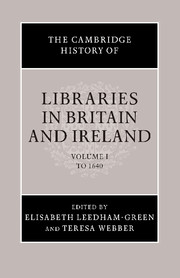Book contents
- Frontmatter
- Introduction
- The physical setting
- Part One The medieval library
- Part Two Reformation, dissolution, new learning
- Part Three Tools of the trade
- Part Four Libraries for leisure
- 21 ‘The profession of a gentleman’: books for the gentry and the nobility (c. 1560 to 1640)
- 22 Libraries of the ‘common sort’
- 23 The libraries of the antiquaries (c. 1580–1640) and the idea of a national collection
- Part Five Organisation and administration
- Select bibliography
- General index
- Index of manuscripts
- References
21 - ‘The profession of a gentleman’: books for the gentry and the nobility (c. 1560 to 1640)
from Part Four - Libraries for leisure
Published online by Cambridge University Press: 28 March 2008
- Frontmatter
- Introduction
- The physical setting
- Part One The medieval library
- Part Two Reformation, dissolution, new learning
- Part Three Tools of the trade
- Part Four Libraries for leisure
- 21 ‘The profession of a gentleman’: books for the gentry and the nobility (c. 1560 to 1640)
- 22 Libraries of the ‘common sort’
- 23 The libraries of the antiquaries (c. 1580–1640) and the idea of a national collection
- Part Five Organisation and administration
- Select bibliography
- General index
- Index of manuscripts
- References
Summary
The great era of country-house libraries – often perceived as ‘libraries for leisure’ – was undoubtedly the eighteenth century, but evidence survives for more than a hundred ‘gentry’ libraries during the period 1560–1640 and many more have, no doubt, disappeared without trace. By any standards, some of these were significant collections, rivalling in size those of many institutions and many belonging to professional men such as churchmen and lawyers. We aim to look at the libraries of both the nobility and the gentry for this period and attempt to place them in the context of the great social and political changes that were taking place in the period encompassing the end of the Tudor dynasty and that of the first of the Stuarts, culminating in the anarchy of the Civil War, which destroyed and dispersed many libraries.
Gentlemen’s libraries come in all shapes and sizes during the eighty years covered by our survey and a similar diversity can be seen in the attitude of their owners to books and learning in general. Ownership of a library did not of itself imply a scholarly outlook or deep learning. The stereotype of the pleasure-loving, hunting and hawking country gentleman is certainly well attested in our period: ‘never a lover of bookes, butt of all corporall exercises and pleasures, as dancing, hunting, hauking, and such country sports, which made him of a robust complexion’ was a grandson’s tribute to Sir William Guise of Elmore. But this was only part of the picture, as surviving gentlemen’s libraries, catalogues, inventories and their own scholarly activities bear witness.
- Type
- Chapter
- Information
- The Cambridge History of Libraries in Britain and Ireland , pp. 489 - 519Publisher: Cambridge University PressPrint publication year: 2006



